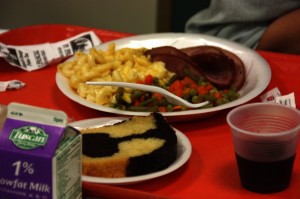
When the winter wind from the Hudson River comes howling onto Eleventh Avenue, Peter Menendez, 60, is unable to get from his home to the Clinton Senior Center, where lunch costs only a voluntary contribution of $1.50. Menendez lives a couple of blocks away from the center, which is at 530 West 55th street, but because of an arteriovenous malformation to the brain, a tangle of poorly-formed blood vessels, he can only rely on one arm and one leg. “When it’s windy, when snow is on the ground, or even when it’s raining I can’t go out,” said Menendez. Instead, he orders food from D’Agostino, a supermarket on Tenth Avenue, or from one of the nearby delis where a single apple costs 75 cents.
“Once I called up D’Agostino because I wanted a cooked chicken, and the lady told me that it would be ten dollars right off the bat for delivery, and then the tip. It would cost me $20 for a chicken,” said Menendez. A whole rotisserie chicken at D’Agostino costs $5.80.
Like Menendez, many other senior citizens in Hell’s Kitchen find that reaching the center during the winter is a challenge. The center, which has over 700 members, is managed by Project Find, an organization that provides services to the elderly and relies on funding from NYC Department of the Aging (DFTA). It used to provide home delivery of meals, but funding cuts have made that impossible since 2009.
“Some members are really frail, so with snow and ice they don’t take the chance of coming out,” said Trenace Simmons, Clinton Senior Center director. “Last year, we had at least 20% of our members that just couldn’t come. We were able to get some meals out, but not to everyone, because we don’t have enough manpower,” added Simmons. There are currently six people on staff.
“I noticed that when there was a snow day, they would wait about one or two days so the snow either melted or the city cleaned it up. When it got safe, they would come back,” said Simmons.
In February of 2011 the center served a total of 1399 meals, compared to 1802 in March. “Occasionally during very bad winter days, staff can’t reach the center and it remains closed,” said Simmons. Although closings have some impact on attendance figures, they don’t account for the increase as the weather improves: the minimum number of meals per day in February was 61, compared to a minimum of 79 per day in March and an annual average of around 100.
“Our numbers don’t go drastically low, but for me that 20% is a lot of people who are not eating lunch that day and have to figure out another way. They’re on fixed income, so it’s not in their budget [ordering out] and they bank on this meal,” said Simmons.

The cafeteria hosts up to 172 people: regulars often sit at the same table with their ethnic clique. Once a month the center celebrates birthdays.
“This is like a second home, thank God the center is here. Last year I had open-heart surgery and people came to visit me in the hospital,” said Ann Diaz, 75, who is originally from Puerto Rico. Diaz lives alone in the low-income housing projects across the street and attends the center for recreational activities.
To meet DFTA requirements, six-month-cycle menus must be approved by a licensed nutritionist and meals must be low-sodium, contain no trans-fats, provide a balanced amount of protein and be a source of vitamins A and C.
“I like the chicken on Tuesdays and Thursdays. I never come on Fridays, because I don’t like the fish,” said Menendez.
A typical Tuesday or Thursday menu includes orange juice, barbeque chicken, yellow Spanish rice, mixed vegetables, a slice of whole wheat bread and an apple. On Fridays, the featured fish dishes include salmon with lemon sauce, tilapia fillet and breaded fish.
“Our budget per meal is $2.41. Sometimes we make it and sometimes we don’t, because of fluctuation in pricing, especially the price of gas, which might be added on to the bill,” said Wayne Burse, assistant director and accountant at the center. Burse has been working for Project Find for the past 15 years, during which he has seen prices go up and public funding decrease. “We’ve been lucky, bread and milk prices have remained the same,” said Burse.
He remembers when $2.10 were sufficient to cover a meal. Today, wholesale suppliers might add up to $8.00 as a fuel surcharge for delivery of a month’s worth of groceries.
“In November we start stacking up on canned goods or frozen vegetables and then we can cut back on fresh vegetables which get more expensive during the winter,” said Burse.
To save on costly low-sodium products, the center’s cook, Shawn Black, makes gravy and sauces from scratch. “The secret is fresh seasonings, like fresh garlic and onions. That drops the price of everything,” said Black, who has been working at the center for six years.
As in any large family, common sense and frugality are key in making ends meet.
“I have two sons which are grown men now, and here I apply exactly the same principles I applied at home back when they were growing up. What we didn’t need, we didn’t get,” said Burse.